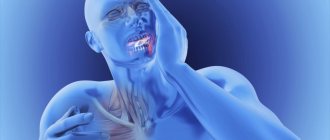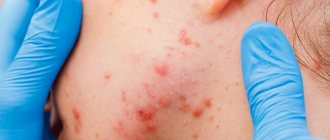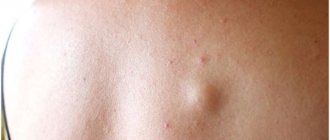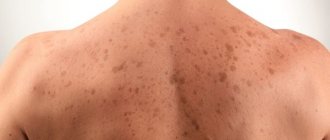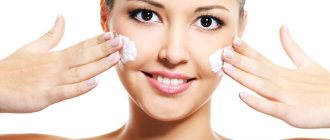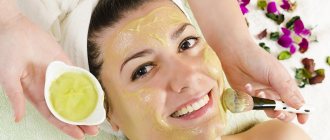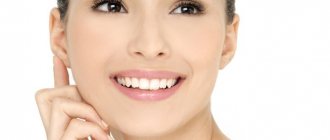What is leather
The skin consists of epidermis, dermis and subcutaneous adipose tissue.
On the body of an adult man there can be up to 2 square meters of skin, which weighs about 4 kilograms. It protects and allows you to maintain a stable body temperature, performs secretory and immunological functions, and is also involved in the metabolism of certain nutrients. There are many dermatological diseases that cause changes in the appearance of the skin. But sometimes, based on her condition, diseases of the internal organs can be diagnosed.
In order for our skin to have a healthy appearance, the endocrine, circulatory, nervous and digestive systems, especially the stomach, liver and intestines, must function properly in the body. In addition, the condition of our outer shell significantly depends on nutrition, consumption of sufficient amounts of vitamins and microelements.
If any of the systems fails, this affects the appearance of the skin: it may change shade, become dry or, conversely, sweat a lot, become covered with spots or pimples. By the way, at one time the Russian surgeon and anatomist Nikolai Pirogov developed an atlas in which he described different conditions of human skin. Based on this guide, several dozen diseases can still be identified today.
What causes pigment spots to appear on the face after sunbathing?
Most manifestations of hyperpigmentation occur after the negative effects of ultraviolet rays. Among those that immediately appear are freckles, various melasma and chloasma. There are also those that have a cumulative effect, for example, lentigo.
Also, if during the summer vacation there were inflammatory processes in open areas of the body, most likely after they heal, a change in shade can be clearly observed.
Prolonged exposure to the hot sun with the presence of existing tumors and increased pigmentation can be fraught with the degeneration of harmless spots into aggressive cancer - melanoma. Therefore, you should limit your tanning time and use special cosmetics for protection.
Which doctors should I contact if I have jaundice?
Emergency physician Gastroenterologist Infectious disease Hematologist
At the first signs of yellowing of the skin or mucous membranes, as well as darkening of the urine, you should immediately consult a doctor!
If you begin to notice that your skin takes on a yellow tint, or the sclera takes on the same color, then you have probably contracted jaundice. Jaundice has never been an independent disease, and is more likely to be understood as a condition that shows that something is wrong in the body and you need medical supervision. The yellow “coloring” of the skin and sclera indicates the accumulation of bilirubin in the blood. Bilirubins are yellow pigments or products of the natural breakdown of red blood cells in the liver.
Most often, bilirubin combines with the contents of the digestive system and “exits” from the body. However, if it was not completely eliminated, it accumulates, which will indicate the presence of infection, blockage of the bile ducts or other liver complications.
Symptoms
The sclera and skin acquire a yellow tint. The urine turns dark brown (may resemble tea). Pale stool. You feel feverish and have chills. Frequent discomfort in the right upper abdomen. You lose your appetite and maybe your weight.
Difficulties
Newborns stop “suffering” from jaundice after a short period. But sometimes there is an inability to remove bilirubin from the body, which can lead to anemia, which can then become the beginning of an insufficient supply of blood to the tissues and cells of the body. As a result, it can lead to physical and mental developmental delays.
What are your reactions
Visit less, and especially dine in cafes/restaurants where their cleanliness is questionable, and also use contraception when having sex with a partner who is infected.
Call your doctor if you notice even one sign of jaundice.
The medicine should be taken only as prescribed by your doctor and consult with him about any disorders or deterioration in health. Follow all the doctor's instructions, they must be followed. You may not realize that the treatment process can change due to the causes of jaundice, but it is true. When you feel much better, the yellow tint to your skin may disappear.
How can a doctor help?
We recommend that you consult a doctor, and the sooner, the better for your health. Jaundice can be cured in different ways, and it depends only on the causes of the disease. Your doctor will tell you to have your blood tested, measure your liver function, do a liver biopsy, and sometimes give you special radiation to identify the cause of the disease and decide on the best treatment. Treatment may include taking medications, involving surgeons, it all depends on the causes of jaundice. If you use phototherapy, then due to irradiation, bilirubin breaks down and becomes much better excreted. In some cases, jaundice in newborns is caused by atresia of the bile ducts (lack of lumens). In this case, surgery is necessary during the first six weeks of the child’s life; this is the period and methods that can help achieve significant improvements in the child’s condition.
Visitor question:
I am shocked and upset - both my child and I have yellow skin. Not everywhere, but in spots: yellow skin on the face, the child has a yellow ear, a large uneven yellow spot on the arm, yellow skin on the stomach and on the leg. All my fingers and palms are yellowish, and there are spots on my face. I’m horrified, I discovered all this now in the evening after a walk. Why can the skin turn yellow, what to do? Oh, I'm afraid of the worst thing - jaundice. But no one in our country had it and there was no contact with strangers, and jaundice is transmitted through hands, as far as I know. I don’t want to call an ambulance, it’s better to wait for the local police officer from the clinic tomorrow, but I definitely won’t sleep all night, I’ll tear my hair out. Or is it better to go to an ambulance? What to do, who has experience?
1. Massage the inside of your palm.
2. Yawn. This way you will get more oxygen and relax your facial muscles.
3. Prepare a decoction of viburnum. This drink is very calming.
4. Take a contrast shower. This helps to “reboot” your body.
5. Listen to relaxing music.
Comments 7
Skin color is initially determined by the race to which a person belongs. And if you have fair skin, with a pink tint and blush on your cheeks, then the appearance of an unusual and frightening yellowish color of the epidermis indicates some kind of malfunction in the body.
Content:
- How does alcoholic liver disease develop?
- Clinical manifestations 2.1. Steatosis 2.2. Hepatitis 2.3. Cirrhosis
- Diagnostics
- Treatment of alcoholic liver disease
First of all, alcohol abuse affects the condition of the liver, and at the initial stage of alcoholism, the symptoms of disorders of the hepatobiliary system are non-specific, and many “attribute” them to withdrawal syndrome, unbalanced nutrition, and lack of sleep. But yellowness of the skin and sclera after heavy drinking indicates progressive liver damage, which requires immediate comprehensive diagnosis, treatment and, of course, a categorical refusal of alcohol.
Yellow skin with normal bilirubin. Jaundice first. Suprahepatic
This jaundice, like the next two, is caused by an increased content of the pigment bilirubin in the blood. Where does it even come from? From destroyed red blood cells. When red blood cells die, whether for natural or pathological reasons, the released hemoglobin turns into biliverdin (which gives bruises their greenish color), and then into bilirubin (which makes bruises “yellow”). In the liver, bilirubin passes into a “bound” form, and is then excreted through the bile ducts and intestines with feces.
Normally, bilirubin reaches the liver so quickly that its level in the blood is low and constant. However, if for some reason there is a massive breakdown of red blood cells, the liver cannot cope, and the level of unbound, “free” pigment in the blood increases. As a result, the sclera of the eyes, mucous membranes and skin acquire a lemon-yellow color. The same situation occurs if liver cells are unable to bind bilirubin (this happens, for example, with a hereditary disease - Gilbert's syndrome).
Massive breakdown of red blood cells most often occurs in acute poisoning with hemolytic poisons and anaphylactic shock that develops due to incompatibility of the transfused blood and the patient’s blood. In addition, this condition can occur due to mechanical effects on red blood cells (for example, when filtering blood on a heart-lung machine, plasmapheresis or hemodialysis machines). Also, the cause of destruction of red blood cells can be hereditary pathology - genetically determined defects in the structure of the cells themselves.
Newborns also have suprahepatic jaundice - normally it goes away in the first few days after birth, its cause is the immaturity of the liver enzyme systems.
Methods for removing xanthelasma of the eyelids
Removal of eyelid xanthelasma is carried out using different methods on an outpatient basis:
- Traditional - using a scalpel. Surgical intervention is accompanied by suturing. Scar formation is possible. Bleeding inevitably occurs and there is a possibility of infection. This method is used for large growths or if there is sagging of the upper eyelid. At the same time, formation and excess skin are removed. There is a possibility of relapse. Therefore, plaque fusion should not be allowed to occur.
- Low temperature most often uses liquid nitrogen as a refrigerant. At a temperature of minus one hundred and ninety degrees, freezing and destruction of the structure of the fatty plaque occurs with excellent cosmetic consequences. It is difficult to protect the eye from cold temperatures, but there is minimal risk of infection.
- Radio waves act with waves of a given frequency. Under the influence of heat emanating from a thin electrode, the neoplasm cells die, providing a good aesthetic effect. Minimal risk of complications and recurrence after resection.
- A chemical is used to burn out the plaque, usually using trichloroacetic acid. Rarely used due to the risk of the reagent getting into the eyes.
- Electrocoagulation works using high frequency current. An electrode is placed on the tumor, current is applied to it, and the cells of the growth are destroyed. The cauterization site finally heals after ten days. Special ointments are applied to it. The method is suitable for small formations. There is no risk of retinal burns.
- Laser evaporates the formation with a laser beam. The method of laser treatment of tumors is considered today the most effective and safe, but quite expensive. The procedure is performed under local anesthesia. The patient's eyes are protected with special glasses. The wound heals under a crust in a few days. An experienced doctor is able to remove all formations in one visit.
Advantages of laser xanthelasma removal:
- No injury to adjacent tissues of healthy skin;
- bloodless, sterile method;
- high accuracy of the beam hitting the affected area to the required depth;
- absence of scars;
- fast recovery;
- harmless to the mucous membranes of the eye.
Diagnostics
A therapist will tell you how to determine what causes a change in complexion. When prescribing your tests or recommending a consultation with a more specialized specialist, he will proceed from the new shade of your skin.
So, if your face is pale, you will be prescribed:
- general blood test with mandatory determination of reticulocytes - the ancestors of red blood cells;
- osmotic resistance of erythrocytes;
- coagulogram;
- liver tests.
If you are concerned about yellowness, the therapist refers you to an infectious disease specialist, and he, focusing on the history of your life and this disease, as well as ultrasound of the liver, gallbladder and pancreas, liver tests and markers for viral hepatitis, decides whether he, a gastroenterologist or hematologist.
Olive complexion requires the attention of a gastroenterologist, who will examine, palpate and listen to your stomach, prescribe an ultrasound of the abdominal cavity (it is performed after preparation) and FEGDS (here you will have to swallow the probe).
Black or blue shades that appear overnight, especially if there is a feeling of lack of air, require calling an ambulance. These specialists will figure out who should consult or treat you. If black spots are bothering you, but there are no other symptoms, it is advisable to consult the staff of the Department of Dermatology.
Cardiologists will help determine the reasons for the red color. These doctors will come to the aid of a tonometer for measuring blood pressure and an ECG. They will probably also need an ultrasound of your kidneys and adrenal glands to find out the cause of your high blood pressure, as well as an ultrasound of your heart.
What is hemolytic disease of the newborn?
Only 10% of all jaundices are pathological. This means that they may require more careful monitoring of the newborn, additional examination and treatment. In approximately 1% of newborns, jaundice is caused by hemolytic disease of the newborn (HDN).
Why does HDN occur? The reasons are differences in blood group, Rh factor or other factors of incompatibility between the blood of the fetus and mother. So, HDN occurs if:
- a Rh-negative mother has a fetus with Rh-positive blood;
- The mother has blood type 1, and the baby has 2 or 3.
Such differences lead to the formation of substances in the mother’s blood that destroy the red blood cells of the fetus. As a result, excessive amounts of hemoglobin and then bilirubin are released into the fetal blood.
What causes yellow skin?
Most often, people begin to think about skin color when they notice pronounced yellowness. The most common cause of yellowing is excess bilirubin in the blood. Bilirubin is a breakdown product of the iron-containing protein hemoglobin, which is responsible for the movement of oxygen and carbon dioxide. This blood pigment usually accumulates in the blood due to liver disease and blockage of the bile ducts. Yellowness caused by excess bilirubin primarily appears on the palms of the hands, the underside of the tongue, and the sclera of the eyes.
In addition to liver diseases, yellowing of the skin can be caused by improper functioning of the thyroid gland, namely a lack of substances capable of breaking down beta-carotene. A bloodless yellow complexion indicates the development of cancer, and staining of the iris and eyelids can be caused by excess cholesterol or abnormal lipid metabolism. In general, yellowness appears when:
- diseases of the digestive system;
- oncological diseases;
- diseases of the endocrine system;
- diseases of the excretory system.
If the yellowness of the skin does not go away over a long period, you should go to a gastroenterologist, infectious disease specialist or hematologist. Only a doctor can make a correct diagnosis after the necessary examination, so try to avoid self-medication.
It is worth remembering that bad habits and bad food provoke the appearance of unhealthy skin. Also, a yellow complexion is characteristic of people who eat a lot of carrots, oranges, pumpkin and some medications, and also regularly use cosmetics based on these products.
Snow Queen symptoms: excessive pallor
Often, prolonged pale skin is perceived by others as a symptom of a certain illness. Unfortunately, very often people are mistaken in their forecasts and do not pay due attention to the harbinger of trouble. But pallor can indicate a variety of diseases, from angina pectoris to iron deficiency anemia. In fact, the reasons for a pale complexion are not always so frightening, but if a person daily hears compliments similar to “You have no face!” Isn’t it time to see a doctor?
In case of kidney disease, pallor is accompanied by swelling, and in case of iron deficiency anemia - low blood pressure and fatigue. The area of the face around the lips and nose is responsible for diseases of the cardiovascular system. Pale skin also indicates an ulcer, duodenal disease and various infectious diseases. Pallor also accompanies a number of other ailments:
- low pressure;
- lack of certain hormones;
- tuberculosis and other lung diseases;
- vitamin deficiency and hypovitaminosis.
Short-term pallor can be caused by fear, stress, pain and cold. A person turns pale from sudden temperature changes. It is especially common to find pale skin color in people who lead a sedentary lifestyle.
How to restore healthy skin color
The standard of a beautiful skin color is a pinkish tint with a slight blush on the cheeks. You need to start achieving a healthy skin color by visiting a doctor and treating existing diseases. Then you can only speed up the process of restoring your complexion
To begin with, it is important to get rid of bad habits and follow a proper diet. Ensure regular physical activity and get enough time outdoors every day
It is worth filling your life with joyful moments and pleasant emotions, reducing stress, getting enough sleep regularly and learning to enjoy life. Yellow and pale complexion will disappear after eating unripe dates, figs, rare meats and healthy seasonings. Good wine in moderation, onions, radishes and cabbage will restore freshness and beauty. Don’t forget about skin care using products prepared with your own hands according to a variety of folk recipes. The main thing to remember is that healthy skin is an indicator of the health of the whole body!
Why does jaundice last?
In some cases, jaundice may be more severe: with higher levels of free bilirubin and/or lasting up to 3-4 months. There are several reasons for this:
- A reduced volume of breast milk or formula, and nutritional deficiencies immediately after birth somewhat worsen and prolong the course of jaundice.
- Fully breastfeeding in the first months of life can prolong the period of jaundice and increase bilirubin levels. This condition is called breast milk jaundice.
The cause of “breast milk jaundice” is still not clear. You can talk about such jaundice if it:
- delayed longer than 1-2 months of life;
- bilirubin level remains above 170-180 µmol/l;
- there is a tendency to a slow decrease in bilirubin;
- temporary withdrawal of breastfeeding leads to a sharp decrease in blood bilirubin.
Both conditions are safe for the baby and do not require treatment. In case of breastfeeding jaundice, in rare cases, with very high blood bilirubin levels, the doctor may recommend a temporary refusal of breast milk. However, in the vast majority of cases this is not required. Neither Russian nor international clinical recommendations recommend weaning such a baby.
Poor nutrition and lifestyle
Are you already panicking, are you going to the doctor? Calm down - maybe everything is not so dramatic, and your skin turned yellow simply because you:
- A big fan of freshly squeezed carrot juice, Korean salads and other carrot dishes.
- Every day you load up on carotene-rich fruits and vegetables (and this includes not only tangerines, oranges and other citrus fruits, but also broccoli, pumpkin and rose hips).
- You put too much vinegar and cumin in your food.
- You smoke too much.
- She has a big sweet tooth and can’t go a day without sweets, cakes and pastries.
- A confirmed night owl and coffee lover. Yes, yes - your skin may have turned yellow due to lack of sleep and caffeine addiction.
- Do you like to pump iron and go on starvation diets at the same time? The combination is not the most advantageous - it sometimes makes your face turn yellow.
- A fan of solariums and sunbathing. Don’t forget - everything should be in moderation, even the source of life - the sun.
arrow_left
Smoking is one of the common causes of yellowing of the skin
The sun can not only “yellow” the skin, but also age it. To avoid this, read how to make a protein face mask against wrinkles.
Red
See a doctor urgently!
Redness of the face can be either an independent disease - rosacea (it is characterized not only by redness, but also by a rush of blood to the face), or a symptom of various internal problems: arterial hypertension, diseases of the gastrointestinal tract, in particular the liver, infectious diseases. In addition, redness can develop as an allergic reaction. In this case, you must first eliminate the allergen, and then treat the skin with anti-inflammatory drugs, and, according to indications, prescribe hyposensitizing therapy.
Or to a cosmetologist?
If your face turns red periodically, it is necessary to choose care aimed at protecting the skin from aggressive factors. These are usually products for sensitive skin. Also in the arsenal of cosmetologists there are injectable drugs that reduce vascular reactivity - mesobotox; mesotherapy and biorevitalizing preparations that restore and protect the skin.
Sallow complexion and acne. 8 signs that it’s time for you to see a doctor Read more
Which nation has yellow skin color. How to determine nationality?
Nationality is a set of character traits that have developed over centuries of history and external data that distinguish an individual from representatives of another nationality. It is noteworthy that people living in neighboring regions differ only slightly in national characteristics, while representatives of different continents differ radically. Such differences between nationalities turn into racial ones. Before determining a person’s nationality, you must know the basic characteristics in appearance by which you can distinguish representatives of different nationalities - hair and skin color, shape and shape of the nose, as well as eyes. Representatives of different nationalities also have speech differences, but they will not always allow one to determine a specific nationality, since half the world speaks English, not just the British.
National differences of Africans
The skin of Africans (or blacks) ranges in color from brown to black. Pure-blooded Africans will never have blue or gray eyes - only black or brown. The shape of the eyes can be either round or almond-shaped. The nose is slightly flattened, with wide nostrils. Representatives of the African continent have dark and, as a rule, curly hair, broad shoulders and long legs, and they are tall.
National differences of Chechens
Both Chechens and Ingushets have light skin. Eye color - brown or black, small eyes. Dark and thick hair, eyebrows fused on the bridge of the nose are distinctive features of Chechens, who also have a straight and large nose with a wide bridge. The height of representatives of this nationality is approximately average. The figure is proportional.
National differences of Georgians
Very often, belonging to a particular nationality can be determined by last name. For example, native Georgians have a surname ending in “dze”. Therefore, how to determine nationality by last name is written in the relevant literature. In addition to their surname, Georgians can be distinguished by their light skin, almond-shaped brown or black eyes, an elongated nose with a hump, and thick, pitch-black hair. Representatives of this nationality have a proportional figure; in terms of height, Georgians are usually tall people, and not only men, but also women.
National differences of Jews
Jews have light skin, often with freckles, protruding and round eyes, gray or brown in color, and they have a large nose with a downturned tip. As a rule, the edges of the nostrils of Jews are slightly raised upward. This nationality has either dark or red hair. If you need to identify a Jew from the male half of society, then take a closer look at his facial hair - it is often different in tone from that on his head. Jews are a short nation, so there are no tall people among them, and often men are characterized by below average height. The Jewish figure has a disproportionate structure - they have a wide pelvis and narrow shoulders.
National differences of Armenians
Before determining nationality by appearance, take a closer look at the eyes - perhaps an Armenian is standing in front of you if the person’s eyes are almond-shaped, wide-set, and brown in color. Armenians have fair skin and thick and curly hair. Especially in men, dense vegetation is observed throughout the body. Armenians have a long, hooked nose, medium to tall stature, and a proportional build.
National differences of the Chinese
In order to determine the nationality of a person, it is not necessary to see him in person, since you can determine the nationality from a photo. The Chinese nationality, the most numerous on our planet, is characterized by a small and narrow nose, slanted and wide-set eyes - they are black. The Chinese have yellowish or brownish skin color and short stature. The physique of representatives of this nationality is proportional. The hair of the Chinese is dark and coarse, straight, and there is practically no hair on the body of men.
National differences of the Tatars
Tatars have a yellowish skin tone and dark or red hair, and representatives of this nationality often begin to go bald at a young age. Their eyes are brown and narrow, as is their nose, which in profile practically does not protrude above the rest of their facial features. Therefore, the face of Tatars often appears flat. Proportional physique and average or below average height are the national differences of this nation.
We hope that this information has helped you in deciding the question of how to determine your nationality or the nationality of your friend or friend.
How does HDN occur?
Features of the course of HDN are:
- earlier (as early as 1 day) onset of jaundice;
- the ability to achieve higher (sometimes critical) bilirubin numbers;
- high intensity of skin coloring;
- the presence of other symptoms - swelling, enlargement of the liver and spleen, lethargy, refusal to eat;
- possible addition of neurological symptoms;
- presence of anemia in a blood test;
- positive Coombs test.
HDN can be either mild or quite severe. As a rule, jaundice is easier when there is blood group incompatibility, and more severe when there is incompatibility according to the Rh factor.
Common Symptom Causes
There are many provoking factors for this syndrome. They are directly related to disruption of the internal processes of the body, but are not always truly dangerous. If a child has yellow skin, it is necessary to urgently show the baby to a pediatrician. Remember - acute hepatitis that is not treated in time can become the main cause of severe complications, and even end tragically, causing death.
Yellow skin - causes:
The types of acute hepatitis may vary depending on the underlying disorders and the clinical picture of the disease. Doctors divide jaundice into three main types.
- Hemolytic jaundice originates due to the intensive breakdown of hemoglobin proteins. In this case, the liver stops performing its direct functions, converting indirect bilirubin into direct bilirubin. The yellow tint of the skin is formed precisely because of the high concentration of indirect bilirubin in the patient’s blood.
- Hepatic jaundice occurs due to various lesions of the liver tissue. These can be serious inflammatory processes, hepatitis with viral etiology, severe liver intoxication (caused by excessive consumption of alcohol, some narcotic and psychoactive substances, inhalation of toxic fumes, taking medications with corresponding side effects), leptospirosis, false tuberculosis, cirrhosis of the liver. Under the influence of these factors, the level of direct bilirubin in the patient’s body increases. The reason for this is the reabsorption of the substance into the bloodstream due to the inability of the liver to process it normally.
- Cholestatic jaundice is caused by damage to the gallbladder and bile ducts. It especially often occurs in the case of blockage of the bile ducts, due to which the fluid cannot circulate in the drainage organs. This effect is mainly associated with benign neoplasms in the gallbladder (stones), or tumor growths, including oncology. In this case, an excessive accumulation of direct bilirubin occurs due to a violation of its entry into the biliary tract and the effect of reverse absorption into the blood.
Norm
Jaundice occurs due to disruption of bilirubin metabolism, its excretion and accumulation.
Bilirubin tends to form due to cytochromes, red blood cells and myoglobin, which have broken down.
Bilirubin comes in two forms:
- Incoherent. It is toxic, interacts with the protein albumin, and is transported to the liver area through the bloodstream;
- Connected. Cells that are in the liver area combine bilirubin and glucuronic acid, changing it into direct or conjugated bilirubin. Next, the liver produces bile, where bilirubin will be located, and it enters the intestines with it. Next, bilirubin is removed from the feces.
Yellow complexion due to cancer. Obstructive jaundice in liver cancer: prognosis and treatment
Obstructive jaundice in cancer is manifested by yellowing of the skin, sclera and mucous membranes. The development of this pathology significantly complicates further treatment of a cancer patient and aggravates his condition. Diagnosis of this disease is made using non-invasive and invasive methods, and only surgical methods are used in treatment - palliative or radical surgery.
Obstructive jaundice due to liver tumor
Jaundice in cancer is a serious complication that is practically not amenable to drug treatment. The mechanism of formation of jaundice in oncology is quite simple and understandable: the cancerous tumor grows, gradually squeezing not only the blood vessels, but also the internal and external bile ducts. As a result, bile simply has nowhere to go, and it begins to accumulate in the vascular bed. Normally, it flows into the intestinal lumen, where it performs its beneficial functions. However, its excess in the blood, i.e., an increase in the concentration of bilirubin, creates extremely favorable conditions for further progression of the disease
Outwardly, the patient, first of all, will pay attention to the yellowing of the skin due to cancer: if before this the skin was pink, physiological, and perhaps pale, characteristic of oncological pathology, now it is yellowish, and sometimes nuclear yellow. If we are talking about a slight change in skin color, then relatives and the patient himself often mistakenly take this phenomenon as symptoms of some kind of improvement - the body’s adaptation to cancer; but in fact they have stepped through another stage of cancer development
Is it necessary to treat physiological jaundice?
Physiological jaundice in newborns does not require treatment with medications, but you should adhere to some recommendations:
- A nursing mother needs to put her baby to her breast more often and not take long breaks between feedings. This promotes normal bowel movements in the child, and most of the bilirubin is excreted from the body in feces;
- bottle-fed babies also require frequent feeding with small portions, with mandatory supplementation with water.
Symptoms of diseases based on skin tone
Pale skin tone is a symptom of anemia
Have you often been told lately that you are as pale as a ghost? Do not be criminally frivolous. This pallor may be a symptom of anemia, in which there are low numbers of red blood cells in the blood. Although there are different types of anemia, the most common is iron deficiency, which occurs when there is not enough iron in the diet. It is rare in men, but up to 20% of women and a huge number of pregnant women suffer from anemia - about 50%.
Another clear sign of anemia is fatigue, which is why this pathology is called “tired blood.” Other symptoms of anemia include weakness, shortness of breath, irritability and brittle nails. The whites of the eyes (sclera) take on a bluish tint. Although anemia in women is most often associated with diets or heavy menstruation, this disease occurs in men and women during menopause, with internal, especially gastrointestinal, bleeding. Anemia can be caused by bleeding from an ulcer or improper use of aspirin and other non-steroidal anti-inflammatory drugs. In some cases, anemia develops as the first symptom of leukemia and other cancers, especially those associated with the stomach, colon, or esophagus.
Skin with a blue tint is a symptom of what disease?
Have you noticed that the skin has acquired some kind of bluish tint? This may be a sign of cyanosis - a lack of oxygen in the blood. Oxygenated blood has a bright red color
As it loses oxygen, the color changes to a slightly purple color; If oxygen becomes very low, the skin takes on a bluish tint. External changes can appear on the lips, nails, sometimes feet, nose and ears.
Sometimes cyanosis is provoked by external factors - for example, prolonged exposure to cold or cold water or at high altitude. But a bluish tint to the skin that does not go away can warn of a variety of systemic disorders that block the access of oxygen to the blood. Including information about lung diseases: asthma, chronic obstructive pulmonary disease and lung cancer. Cyanosis also develops with cardiac pathologies.
Skin with a yellow tint is a symptom of what disease?
If your skin has a yellowish tint, this is most likely a symptom of jaundice, which primarily causes the whites of the eyes to turn yellow. The yellow color appears due to excess bilirubin in the body - a yellow substance - a breakdown product of red blood cells. But if the skin has turned yellowish-orange, it may be due to carotenemia - a large amount of beta-carotene or vitamin A, coming from dietary supplements or foods, such as carrots.
In some cases, a yellowish tint to the skin is inherited in a harmless form of jaundice called Gilbert's syndrome. But most often, such a change indicates pathologies such as hepatitis, cirrhosis, liver or pancreas cancer. Jaundice can be a symptom of hypothyroidism or infectious mononucleosis, a viral disease also known as the “kissing disease.”
Some people experience discoloration in areas of their skin that have been exposed to perfume or cologne when exposed to the sun. In many cases, the resulting spots remain forever. Signs of hyperthyroidism may include excessively dry skin, split ends and flaky nails.
Jaundice
is a yellowing of the skin and mucous membranes, which is especially noticeable on the eye sclera, the lower surface of the tongue (if the tongue is raised to the upper palate), and also on the palms. This is where jaundice appears first. Yellowing of the skin is also accompanied by darkening of the urine—beer-colored urine—this symptom appears first of all.
Yellowing of the skin is most often a sign of high levels of bilirubin in the blood. Sometimes the skin turns yellow when there is an increased level of carotene in the blood, which happens when you abuse carrot or orange diets.
Bilirubin is a blood pigment that is a breakdown product of hemoglobin. Hemoglobin, in turn, is an iron-containing protein that performs a transport function for oxygen and carbon dioxide and is found in erythrocytes - red blood cells.
Bilirubin can be direct or indirect.
Formed after the breakdown of hemoglobin, bilirubin binds to blood plasma protein. This type of bilirubin is called indirect; it is insoluble in water and cannot be excreted from the body in urine or bile.
Indirect bilirubin enters the liver, where it undergoes a series of biochemical reactions, which leads to the formation of direct bilirubin. Direct bilirubin is freely excreted with bile into the intestines, as well as with urine.
Age spots and peeling
Melanin accumulation occurs in the upper layers of the epidermis. In order to remove unaesthetic problems, products that stimulate the renewal of the dermis are used. The most effective peelings are: chemical, mechanical, laser. They promote the regeneration of epidermal cells, forcing keratinocytes to produce new ones as quickly as possible, which will not have a large accumulation of coloring pigment. When eliminating the root causes of hyperpigmentation, there is a chance that you will forget about various spots for a long time.
What is the treatment for TTH?
Most often, phototherapy is used to treat tension-type headache: the newborn is placed for a while under a lamp emitting light of a certain wavelength. As a rule, phototherapy is well tolerated by babies, but in some cases it can cause dry skin and mucous membranes. Therefore, frequent breastfeeding and additional fluid administration are recommended for children undergoing phototherapy. The duration of phototherapy depends on the level of bilirubin in the blood.
Less commonly, HDN is treated with medications, red blood cells, or intravenous immunoglobulin preparations. In exceptional situations, a replacement blood transfusion is performed. These manipulations are carried out only in a hospital setting.
In some cases, with mild HDN, treatment is not required.
